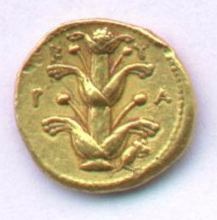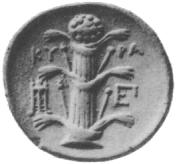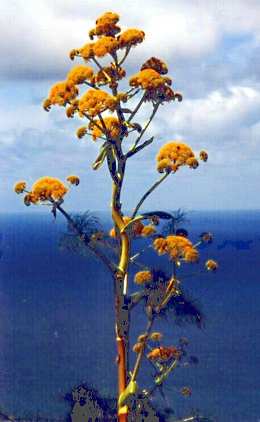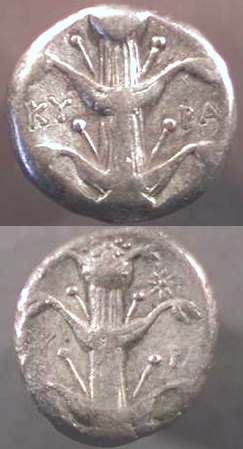
|
| Cyrenean gold drachm showing silphion image |

|
| Ancient silphion coin |
On cooking); Apicius had lived in the first century A.D., but the famous cookbook published under his name is much younger — either it was a later and changed edition, or an independent work just using the name of the then already legendary gourmand.
A late (5.th century) collection of recipes, claiming to originate from the Apicius-cookbook and being compiled by a certain Vinidarius, starts with a long list of items that should be stocked by any good cook. Its beginning refers to spices: (see translations with mouse and CSS1):
Brevis pigmentorum
que in domo
esse debeant
ut condimentis
nihil desit:
crocu,
piper,
zingiber,
lasar,
foliu,
baca mirte,
costu,
cariofilu,
spica indica,
addena,
cardamomu,
spica nardi.
De seminibus hoc:
papaber,
semen rude,
baca rute,
baca lauri,
semen aneti,
semen api,
semen feniculi,
semen ligustici,
semem eruce,
semen coriandri,
cuminu,
anesu,
petrosilenu,
careu,
sisama.
De siccis hoc:
lasaris radices,
menta,
nepeta,
salvia,
cupressu,
origanu,
iuniperum,
cepa gentima,
bacas timmi,
coriandrum,
piretru,
citri,
pastinaca,
cepa ascalonia,
radices iunci,
anet,
puleiu,
ciperum,
aliu,
osprea,
samsucu,
innula,
silpiu,
cardamomu.
Quite remarkably, some of these spices (e. g., saffron,
sage, cloves) are rarely
found in the main texts of the various
Apicius cookbook versions; on the other hand, the important
fresh leaves are not in the list. It is very probable that both silpium
and laser
refer not to the original silphion root, which was long extinct,
but to its Eastern substitute, asafetida.
The following translation of that passage gives classical Latin names as a
mouseover tooltip.
Short list of spices that should be kept in the house so that the sauces will not lack anything: saffron, pepper, ginger, silpium resin, Indian bay-leaves, myrtle berries, costus, cloves, Indian spikenard, addena, cardamom, spikenard.Of the seeds the following: poppy, rue seeds, rue berries, bay berries, dill seeds, celery seeds, fennel seeds, lovage seeds, rocket seeds, coriander seeds, cumin, anise, parsley, caraway, sesame.
Of the dried herbs the following: silpium root, mint, calamint, sage, cypress, oregano, juniper, onion, thyme berries (possibly ajwain), coriander, pellitory, citron, wild parsnip, shallot, reed root, dill, pennyroyal, Cypriotic (grass), garlic, pulses, marjoram, elecampane, Silpium, cardamom.
The Apicius is the only ancient cookbook that
has survived in full; thus it is a most important source of knowledge
about the cuisine of Ancient Rome (see also onion
for a much older cookbook from Mesopotamia). Besides a few isolated recipes scattered
over the literature, another work to mention is the early farming handbook
De agricultura by Marcus Porcius Cato
(2.nd century BC) which serves down-to-earth but tasty fare, e.g., lentils flavoured with silphion.
Social life in the first century AD and is eccentric feasts are
very vividly described in an entertaining narrative
Cena Trimalchionis (The Banquette of Trimalchio
),
which is part of a larger cycle, Satyricon, attributed
to the renowned aesthete and courtier of Nero,
Gaius Petronius Arbiter Elegantiæ
(of Quo Vadis? fame). Last but not least, one should mention
Virgil’s poem moretum which glorifies country life
and describes poetically the preparation of a paste made from raw
garlic, ripened cheese and herbs; see also
rue.
Silphion was highly praised first by Greek and later by Roman cooks and also
highly prized. The plant proved impossible to cultivate; it thrived only in
areas free of any human cultivation. For centuries, the silphion populations
were carefully conserved and harvested by fixed, time-approved rules; but in
the first century BC, the plant became increasingly rare due to both
overharvesting and damage by wars. Possibly, the populations would have
recovered if they had been strictly protected, but grazing sheep destroyed
whatever silphion plant was left, as Plinius reports:
unus omnino caulis nostra memoria repertus Neroni principi missus est
the only stem found in our memory was sent to Emperor Nero
.
Cuisine in ancient Rome was fundamentally different from the cooking style now most associated with Italy: Noodles (pasta) were unknown, tomatoes did not grow outside of the American continent, and even garlic was significantly less popular than today. Yet olive oil has been used since millennia in the Mediterranean, both for cooking and as a lamp fuel.

|
|
Flowers of giant fennel, Ferula communis, a plant often
thought related to ancient silphion.
www2.cinet.it © G. Gandolfo |
Besides a host of herbs some of which are still characteristic of today’s Italy (lovage, celery, bay leaves) and some herbs that have fallen into disfavour since (the bitter rue and pennyroyal, Mentha pulegium, a specific kind of mint) and their favourite condiment mustard, the ancients used other flavourings not found in today’s Italian cooking. There was a general preference of lavishly flavoured foods, and cooks often employed strong flavours many contemporaries would have problems getting used to; even wine was flavoured with rose flowers or, as a cheaper substitute, citron leaves.
Most essential was liquamen, a fish sauce obtained as a by-product in the production of anchovy (fermented fish) and probably similar to products found in today’s South East Asia (nam pla [น้ำปลา] in Thailand, nuoc mam [nước mắm] in Vietnam); it was used for the pungent sauces that accompanied boiled meat or sea food analogous to the sauces for which today French cuisine is so famous. Most popular among the Eastern spices used for such sauces were cumin, black pepper and ginger; even more praised was long pepper, whose high prize and but sporadic availability, though, limited culinary usage. Other spices, like cinnamon, cassia, cloves and Indian bay-leaves (malobathrum, malabathrum) were known but played a lesser rôle in cooking; these were more important for perfumery.
Probably even more amazing compared to today’s taste was the marked preference for sweet–sour–spicy or even solely sweet–spicy combinations. The most important source of sweetness was honey; dried fruits (e. g., raisins or dates) played a much less prominent rôle. Honey was also used for preservation, even of meat. On the other hand, sweetmeats were commonly enriched with a dash of black pepper (see also poppy).
To set sour accents, the Romans mostly used vinegar (and sometimes a decoction of sumac berries), because citrus fruits were unknown except citron, a close but juiceless relative of lemon. Concentrated grape juice, made by boiling young must down to one half (caroenum) or even one third (defrutum) of its original volume, was also frequently employed. A very similar concoction, verjus, was part of French cooking until the end of the Renaissance.
One could speculate that silphion has somehow survived and is now known by another name. Some think that it is a member of genus Laserpitium (named after the ancient spice), other consider it more similar to Ferula, where asafetida belongs to. However, the description of Theophrastus emphasizes that silphion avoids cultivated soil: It is typical for this plant, he writes,
ἀεὶ συνεργαζομένης καὶ συνημερουμένης ἐξαναχωρεῖν ὡς οὐ δεομένου δῆλον ὅτι θεραπείας ἀλλ᾽ ὄντος ἀγρίου
aei synergazomenes kai synemeroumenes exanachorein hos ou deomenou delon hoti therapeias all’ ontos agriou
always to leave [land] which is brought into cultivation and tamed, for it plainly does not miss [human] attendance but is a wild being.
There is little hope for wild things
in these times. With its avoidance of human-inhabited areas, silphion is extremely improbable
to have endured in the densely populated coastal area of North Africa.
Further South, the Sahara has considerably grown in the last two millennia,
and if there have been any retreats of silphion, they must be buried under
desert sand by now.



